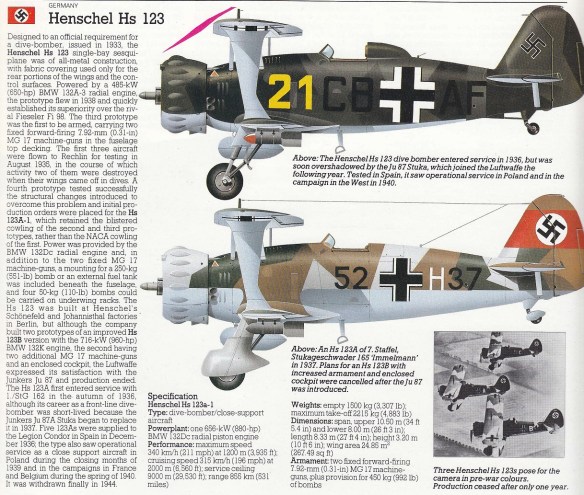On 1 May 1939 a full-scale redesignation of all Luftwaffe units took place; additional to the Stuka units 4 (Stuka)/Trädgergruppe 186 had been formed at Burg, near Magdeburg, for service aboard the uncompleted aircraft carrier Graf Zeppelin and was operating the Ju87B, as was the elite IV (Stuka)/LG 1.
In August 1939, the Hs123s of II (Schlacht)/LG 2 were transferred from their peacetime base at Tutow to Alt Rosenburg close to the Polish frontier, At the same time the Stuka units were also made ready for the invasion which aimed for two massive pincer movements into Poland from north and south. In the north, Luftflotte 1 controlled IV (Stuka)/LG 1, I/St.G 1, II and III/St.G 2 and the 4 (Stuka)/186. Luftflotte 3’s III/St.G 51 operated in the south, together with Luftflotte 4’s I/St.G 76, I and II/St.G 77 and I/St.G 2. The Luftwaffe, in order that it could support the army unhindered by enemy air opposition, had first to gain air superiority by destroying the Polish Air Force on the ground in a series of surprise attacks.
Because of bad weather in the early morning of 1 September 1939, Air Fleet commanders ordered their aircraft off against targets not specified in the priority list, but it was later discovered that Crakow airfield was covered only by a thin mist and I/St.G 2 under Maj. Oskar Dinort (RK, EL 14.7.41) bombed the buildings and runways leaving the airfield under a pall of smoke. Other Stuka units attacked the airfields at Katowitz and Wadowice, whilst Hptm. Sigel (RK, EL 3.9.42) led I/St.G 76 in an attack against a line of emplacements at Lublinitz. During the afternoon a column of Polish soldiers, horses and vehicles was annihilated near Wielun by I/St.G 2 and I/St.G 77 whilst II and III/St.G 2 together with Bern von Brauchitsch’s IV (Stuka)/LG 1 and Hptm. Helmut Mahlke’s 4/(Stuka) 186 attacked ships and harbour installations along the Danzig Bay, virtually eliminating the Polish Navy.
From first light on 1 September, the 36 Hs123s of II (Schlacht)/LG 2 flew as many as ten sorties a day in support of the army’s advance on Warsaw, bombing and strafing a path wherever German troops encountered resistance, often employing ‘Flambos’ – light incendiary bombs fitted with percussion fuses. As they advanced, these aircraft flew from fields that were declared fit for operations by simply driving a car over the surface at 30 mph; if the ride was not too bumpy the field immediately became a forward airstrip! On the second day of the campaign, with the Polish Navy and Air Force almost destroyed, Stuka operations in full support of the ground forces began. Paralysed by these devastatingly accurate air attacks the Poles were unable to contain the Germans’ armoured thrusts, and by 8 September German troops were in the outskirts of Warsaw itself.
Unexpectedly, twelve Polish divisions by-passed at Kutno boldly counter-attacked the flank of the main German advance towards Warsaw, and all available German aircraft were transferred to meet the threat. As the Poles crossed the Bzura several Stuka formations destroyed the bridges, cutting off forces which had already crossed and preventing the bulk of the Polish force from engaging the German 8th Army. For two days the Stukas spread destruction on the Polish armour and vehicles in a continuous and unprecedented aerial attack; while the pilots of II (Schlacht)/LG2 discovered during a low-level mission that the appalling din emitted by the Hs123’s engine when set at 1,800 rpm was sufficient to panic and terrorise the ranks of horses and men below. On 19 September 170,000 surrounded Poles surrendered and the battle of the Bzura was over.
Meanwhile, during the battle of the Vistula, the crews of I/St.G 76 repeatedly attacked the fortress of Modlin, bravely defended until 25 September, when the Luftwaffe prepared for the bombardment of targets in Warsaw. Eight Stukagruppen totalling some 240 aircraft, attacked the city together with medium bombers producing so much smoke and dust that the army complained it could not see the targets it was supposed to be shelling. The aerial assault continued until the 27th, when Warsaw finally surrendered, bringing to an end a campaign from which the Ju87 emerged with a legendary reputation.
